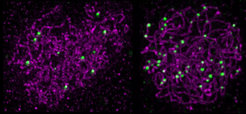Evidence for new theory of genetic recombination
Scientists from the Max Planck Institute for Plant Breeding Research and the Max Planck Institute for Dynamics and Self-Organization (MPI-DS) suggest an explanation for the century-old mystery of how chromosome recombination is regulated during sexual reproduction. Their findings are published in the journal Nature Communications.
In most higher organisms, including humans, every cell carries two versions of each gene, which are referred to as alleles. Each parent passes on one allele to each offspring. As they are linked together on chromosomes, adjacent genes are usually inherited together. However, this is not always the case. Why? The answer is recombination, a process that shuffles the allele content between homologous chromosomes during cell division. Mechanistically, recombination is achieved by crossovers, where homologous chromosomes contact each other, resulting in the exchange of genetic material. Crossovers have long fascinated scientists and especially plant breeders because manipulating the crossover process offers the potential of increasing genetic diversity and of assembling desired combinations of alleles that boost crop productivity. Crossovers are subject to a “Goldilocks principle”; at least one is required per chromosome pair for successful sexual reproduction; indeed, a lack of crossovers is a major cause of human trisomy such as in the case of Down’s Syndrome. Crossover numbers are also tightly regulated and generally do not exceed three. This limit on crossover number, and therefore, recombination, is achieved by crossover interference, a phenomenon through which crossovers inhibit additional crossovers in their vicinity. However, how this interference works has remained a mystery since it was first described some 120 years ago.

Now, a team of scientists from the MPI for Plant Breeding Research in Cologne and the MPI-DS in Göttingen led by Raphael Mercier, found convincing evidence in support of a recently proposed model of crossover interference. Together with collaborators, in work spearheaded by Stéphanie Durand, Qichao Lian, and Juli Jing, they achieved these insights by manipulating the expression of proteins known to be involved in either promoting crossovers or in connecting chromosomes together. The used Arabidopsis thaliana as a model plant to gain fundamental insights into the mechanisms of heredity. In particular, boosting expression of the pro-crossover protein HEI10 resulted in a significant increase in crossovers, as did disrupting the expression of another protein termed ZYP1. This protein is a constituent of the synaptonemal complex, a structure that forms between homologous chromosomes. When the scientists combined the two interventions, they were surprised to observe a massive increase in crossovers, showing that HE10 dosage and ZYP1 jointly control crossover patterning. Importantly, massively increasing crossovers in this way barely affected cell division.
The considerable increase in crossovers upon increasing HEI10 levels chimes well with an emerging model for how crossover number is regulated. Scientists around David Zwicker from the MPI-DS in Göttingen formulated a model based on diffusion of the HEI10 protein along the synaptonemal complex. In the model, HEI10 initially forms multiple small foci and is progressively consolidated into a small number of large foci. This process is similar to a known physical process in which large droplets grow at the expense of small droplets, e.g., in pastis or vinaigrette. As a result of this coarsening process, only few, well-spaced foci remain, which then determine the crossover sites. David Zwicker comments: “It’s fascinating to see that everyday phenomena known since more than 120 years now allow us to explain microscopic phenomena in cells that have been mysterious for as long. This transfer of ideas from the physical to the biological world displays the strength of interdisciplinary teams.”
Mercier is excited by the team’s findings and is already looking ahead: “These results are an exciting insight into a process that has baffled scientists for over a hundred years. Next, we want to better understand what controls the dynamics of the HEI10 droplets and how they promote crossovers. If we can get a better handle on how the process works, this may allow us selectively boost recombination during plant breeding, enabling the assembly of combinations of beneficial alleles that have remained out of reach.”
